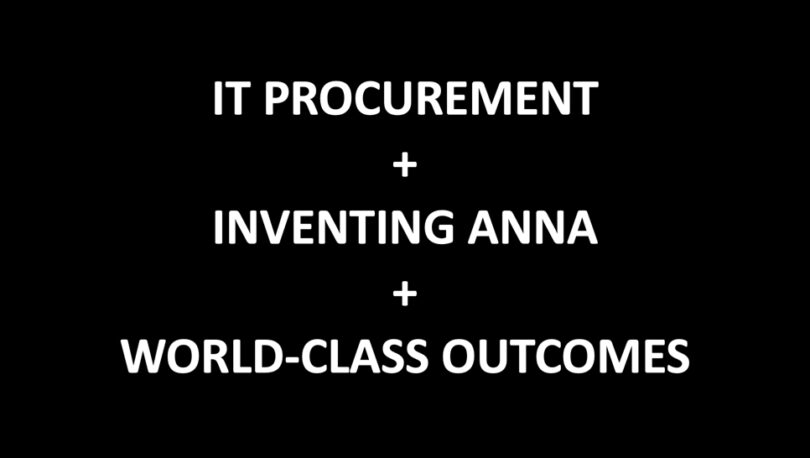Earlier this week, NPI CEO Jon Winsett made the case that IT procurement could learn something from the title character in Inventing Anna. Here’s what he had to say on his LinkedIn post:
Procurement could learn a thing or two from Inventing Anna.
Not the imposter bit, of course. But something about what’s made the story so interesting to so many people.
If you’ve been keeping your ear to the ground, you’ve probably noticed a handful of new terms pop up in procurement circles. One is “world-class outcomes.” It’s a world-class result as compared to peer purchases in the market. Noble for sure, and viable for many organizations. But “world-class” anything doesn’t just happen.
I think of the titular character in Netflix’s Inventing Anna. She was able to infiltrate New York’s upper echelons of high society by fashioning herself as world class. How? She simply knew what world class looked and acted like, impersonated those attributes, and the gatekeepers let her in.
How does Anna’s approach apply to business, or more specifically IT procurement? Well, she started with reconnaissance. If you’re purchasing and renewing technology – be it cloud, software, infrastructure or services – and are attempting to achieve a world-class result, you first need to know what a world-class deal looks like.
So, let’s begin there. A world-class deal is an amalgamation of pricing, licensing, and deal constructs at a moment in time, shaped by trends in vendor behavior and negotiation dynamics.
What makes it challenging is it requires information that most companies don’t have or cannot gain access to easily. What’s needed is a mix of past spend and contracts that are digitized and searchable alongside access to real-time market data and specific supplier dynamics – information like price variability, competitors, licensing pitfalls, business objectives that create leverage, and negotiation subtleties.
For an IT buyer to walk into a vendor negotiation meeting appropriately prepared, they need to have researched that vendor’s quotes and their past deal constructs. They need to have expectations of how that vendor will behave at or near the point of purchase. They need to have identified optimal deal structures and pricing for their unique requirements, grounded in benchmark data. And they need a well-defined negotiation playbook at hand that charts a clear path to a best-in-class deal.
If you have all the tools and intelligence at your fingertips, then world class doesn’t look too far out of reach. Admittedly, it’s an exclusive club and entry isn’t granted on luck or happenstance. But it’s certainly achievable. In the words of Anna: “VIP is always better – you just have to be willing to do the work.”
World-Class Outcomes
It’s worth examining the definition of a “world-class outcome” on enterprise IT deals a bit further:
A world-class deal is an amalgamation of pricing, licensing, and deal constructs at a moment in time, shaped by trends in vendor behavior and negotiation dynamics.
There are two words that stand out in this definition. The first is “amalgamation.” Special credence isn’t given to any individual aspect. It’s the interworking, optimization and combined effect of all facets that create the most favorable outcome possible. You may know a vendor’s licensing programs inside and out, but if you don’t understand pricing nuances or lock yourself into inflexible contract terms, then you may very well have secured a highly unfavorable deal that will haunt your organization (and budget) for years to come.
The second is dynamics. As in the dynamic nature of what’s motivating the vendor at any given point in time. Without an intimate knowledge of what’s driving vendor behavior for your specific transaction, and across the broader customer landscape, you’re coming to the table blind. The same could be said for pricing and licensing.
Ultimately, the difference between securing a world-class outcome and something less than one, is access to real-time market and vendor intel. Not the quadrant stuff or the contract management stuff (both of which are valuable at a certain point in the IT procurement process), but the pricing, licensing and vendor intel that gives you the leverage to secure a deal that’s truly world class.
RELATED CONTENT
